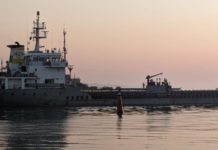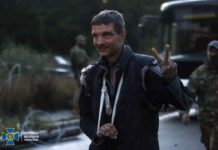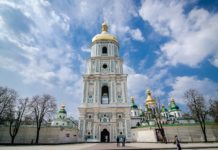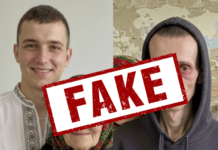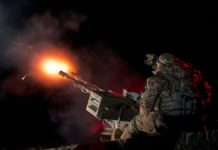As of May 13, 2025, the full-scale Russian invasion of Ukraine has reached day 1,175. Despite diplomatic efforts to establish a 30-day unconditional ceasefire, hostilities remain ongoing. Ukrainian forces continue to hold their defensive lines in the east, while Russian troops persist in targeting civilian infrastructure. Ukrainian President Volodymyr Zelensky insists on direct negotiations with Russian President Vladimir Putin in Turkey, emphasizing that only a personal meeting can lead to real progress toward peace. Meanwhile, international pressure on Russia is mounting, with new sanctions and legal recognition of its responsibility for the downing of Flight MH17 in 2014.
Frontline Situation
As of May 13, 2025, the situation on the front remains extremely tense. A total of 166 combat clashes were recorded across the frontline over the past 24 hours. Russia launched 78 airstrikes, dropped 141 guided bombs, carried out over 5,400 shellings — including 103 attacks using multiple launch rocket systems — and deployed 3,058 kamikaze drones.
- In the Kharkiv direction, Ukrainian troops repelled seven assaults near Vovchansk and Krasne Pershe.
- In the Kupiansk direction, five attacks were repelled near Pishchane, Hlushkivka, and Novoosynove.
- In the Lyman direction, 20 assaults occurred near Zelena Dolyna, Ridkodub, Kolodiazi, and Olhivka.
- In the Siversk direction, six attacks were halted near Hryhorivka and Bilohorivka.
- In the Kramatorsk direction, combat was reported near Vasiukivka, Chasiv Yar, Bila Hora, and Predtechyne.
- In the Toretsk direction, Russian forces launched nine attacks near Diliivka, Petrivka, and Toretsk.
- In the Pokrovsk direction, the most intense action occurred — 60 assaults near Myrnohrad, Oleksiivka, Novomykolaivka, Udachne, and others.
- In the Novopavlivka direction, 24 Russian attacks were repelled near Kostiantynopil, Bahatyr, Zelene Pole, and Novosilky.
- In the Orikhiv direction, six attacks were repelled near Mala Tokmachka and Mali Shcherbaky.
- In the Prydniprovske direction, four assaults towards Sadove were unsuccessful.
- In the Kursk direction, nine combat engagements and 254 artillery attacks were reported, including eight from MLRS, and 20 guided bombs were used in 18 airstrikes.
Ukraine’s defenders maintain their positions, counterattack actively, and neutralize enemy units and equipment. Ukrainian aviation, missile forces, and artillery struck 12 concentrations of enemy personnel and equipment, two communication hubs, three artillery systems, and three additional high-value targets.
Russian Losses
As of May 13, 2025, Russia’s total estimated losses since the beginning of the full-scale invasion include:
- Personnel: approximately 968,130 (+1,070 in the last 24 hours)
- Tanks: 10,802 (+2)
- Armored fighting vehicles: 22,487 (+14)
- Artillery systems: 27,780 (+62)
- MLRS: 1,381
- Air defense systems: 1,162
- Aircraft: 372
- Helicopters: 335
- UAVs (operational-tactical level): 35,778 (+100)
- Cruise missiles: 3,197
- Warships/boats: 28
- Submarines: 1
- Vehicles/fuel tanks: 48,256 (+138)
- Special equipment: 3,884
The elimination of over 1,000 Russian troops and dozens of military assets in a single day significantly undermines the Kremlin’s ability to sustain its offensive momentum along the frontline.
Ukrainian Defense Achievements
On May 13, Ukrainian Defense Forces successfully repelled more than 160 enemy attacks, especially in the Pokrovsk, Lyman, and Novopavlivka sectors. Coordinated action by aviation, artillery, and intelligence units inflicted significant losses on Russian forces:
- 12 concentrations of enemy troops and equipment were struck.
- Three Russian artillery systems were destroyed.
- Two communications hubs and three other critical targets were taken out.
- Ten Shahed-type attack drones were shot down overnight by Ukrainian air defenses.
Ukrainian troops continue to show resilience, coordination, and precision, disrupting enemy operations and degrading Russian capacity in the rear.
Diplomatic Initiatives and Negotiations
As of May 13, 2025, diplomatic activity around the war in Ukraine has intensified amid expectations of a direct meeting between President Volodymyr Zelensky and President Vladimir Putin. Key attention is focused on Turkey’s peace initiative, Ukraine’s firm stance, and international support for peace formats based on Kyiv’s formula.
- Turkish President Recep Tayyip Erdoğan confirmed readiness to host both leaders in Istanbul on May 15 and urged Russia to accept an immediate 30-day ceasefire without preconditions, calling it a “last chance” to halt the war through diplomacy.
- Ukrainian President Volodymyr Zelensky emphasized he would not engage with any Russian representative below Putin. Presidential advisor Mykhailo Podolyak reiterated that no other Russian official has the authority to make binding decisions.
- The Kremlin has not yet confirmed Putin’s attendance. A spokesperson stated that Russia is willing to send a delegation, but Kyiv dismissed this as unacceptable.
- The European Union urged Russia to support a ceasefire ahead of the peace summit scheduled in Switzerland for June, warning that continued hostilities erode trust in Moscow’s intentions.
- The U.S. State Department reaffirmed support for Ukraine’s peace formula and confirmed U.S. participation in preparatory discussions for the Swiss summit. Officials stressed Putin’s personal presence would be a test of Russia’s sincerity.
Ukraine remains firm: negotiations are only possible on its terms. Meanwhile, the international community is increasing pressure on Moscow to demonstrate genuine readiness for peace.
International Support for Ukraine
As of May 13, 2025, Ukraine continues to receive strong international support through military, financial, humanitarian, and political means.
- The European Union approved a €900 million package from frozen Russian assets to fund air defense systems, artillery, and ammunition. This is the first large-scale application of a new EU military procurement mechanism.
- France announced a 44% increase in the production of AASM Hammer precision-guided bombs, with at least 1,200 units to be delivered in 2025 — enhancing Ukraine’s deep-strike capabilities.
- The UK and France launched a renewed “coalition of the willing” with 20 countries pledging expanded military and post-war peacekeeping support for Ukraine.
- Sweden is providing $3 million in humanitarian aid, delivered to Lviv with the involvement of former national football coach Janne Andersson. The aid includes medical supplies, generators, and communications equipment.
- The United24 platform announced over $1 billion raised globally, supporting Ukrainian defense, recovery, medical care, and education — under the supervision of the Cabinet of Ministers and international partners.
- The EU is preparing contingency sanctions in case of a Hungarian veto, including special tariffs, capital controls, and non-consensus sanctions.
Ukraine’s international backing remains steadfast and is growing across all dimensions — military production, economic assistance, humanitarian relief, and diplomatic coalitions.
Humanitarian Situation in Ukraine
As of May 13, 2025, the humanitarian situation remains dire due to ongoing Russian bombardments across frontline and border regions.
- Over 5,400 shellings were recorded, including 103 MLRS strikes. Sumy, Kharkiv, Donetsk, and Kherson regions were hardest hit.
- On the night of May 12–13, Russia launched 10 Shahed drones, all intercepted. In Kharkiv, drone debris damaged energy infrastructure.
- In Sumy, artillery strikes hit Sosnivka, Bila Bereza, Petrushivka, Popivka, and Dmytrivka — injuring at least five civilians and damaging homes.
- In Dnipropetrovsk, shelling disrupted power lines and caused blackouts in parts of Pavlohrad.
- In Donetsk, mass strikes hit Pokrovsk, Novomykolaivka, and Chasiv Yar — destroying over 40 civilian sites, including hospitals and schools.
- In Kherson, Kosaatske and Beryslav were shelled, damaging electricity, water, and school facilities. Evacuation is underway.
- In Zaporizhzhia, a guided bomb strike injured five people in Poltavka.
- The Red Cross and World Central Kitchen delivered aid to frontline areas, including generators, water, and medicine.
- In Lviv, over 2,500 internally displaced people arrived in 48 hours, mostly from Kharkiv and Donetsk. Temporary housing and support services are being provided.
Humanitarian response efforts are under extreme pressure, but both national and international organizations are working to meet critical needs.
Internal Situation in Ukraine
As of May 13, 2025, the internal situation in Ukraine is marked by rising defense needs, legislative efforts to support the military, and state initiatives focused on cybersecurity, mobilization, and the social protection of service members.
- The Ukrainian government is reviewing options to balance the national budget amid reports of potential shortfalls in defense financing. Officials emphasize that the situation remains under control and that funding the armed forces remains a top priority.
- The Verkhovna Rada passed a law allowing dependents of fallen Ukrainian soldiers to quickly receive one-time financial assistance. The legislation aims to strengthen social guarantees for the families of Ukraine’s defenders.
- Ukraine’s Armed Forces continue forming new mechanized brigades under the Land Forces Command. These formations are being deployed in anticipation of intensified fighting in the eastern regions.
- Ukraine is scaling up its capabilities to counter enemy FPV drones. The NATO Innovation Challenge was officially launched in partnership with Ukrainian institutions to develop new detection systems and electronic warfare solutions.
- A new series of psychological assistance courses has been introduced for military personnel and their families. Training includes medical, educational, and social professionals, as well as community-based psychologists.
- The Ministry of Digital Transformation continues implementing the national cybersecurity policy. Educational programs are underway to enhance the resilience of critical infrastructure.
- Martial law and mobilization remain in effect. The General Staff highlights that priority is being given to filling active combat units and preparing specialists for new tech-driven branches of the military.
In summary, Ukraine’s internal landscape reflects the state’s mobilization of resources and institutions to bolster national defense, protect civilians, and support military personnel. The country is adapting to wartime realities through modernization, enhanced social policies, and strengthened cyber capabilities.
Conclusion
Events on May 13 confirm that Russian aggression remains intense and focused on eastern and frontline areas. Ukrainian Defense Forces are holding firm, inflicting heavy losses, and successfully targeting enemy logistics.
Diplomatically, momentum is building ahead of a potential meeting in Istanbul and the Swiss summit in June. Allies continue to increase support — from Patriots to precision bombs — while Ukraine mobilizes resources at home to meet military and civilian needs.
While the war continues, Ukraine appears to be gaining strategic initiative. This creates a vital opportunity for diplomacy, underpinned by ongoing military resilience and international solidarity.
🤝 SUPPORT US 💙💛
We continue to work only because you read and support us. If you appreciate what we do, please become our sponsor or donate here👇
☑️ patreon.com/meanwhileinukraine
or
☕️ buymeacoffee.com/meaninuak
or
☕️ ko-fi.com/meanwhileinua
Your support helps us continue delivering timely and accurate updates. Stay informed and stand with Ukraine! 🇺🇦
Together we are stronger! 🇺🇦






